5 Yrs♥✓#
GreenStarfish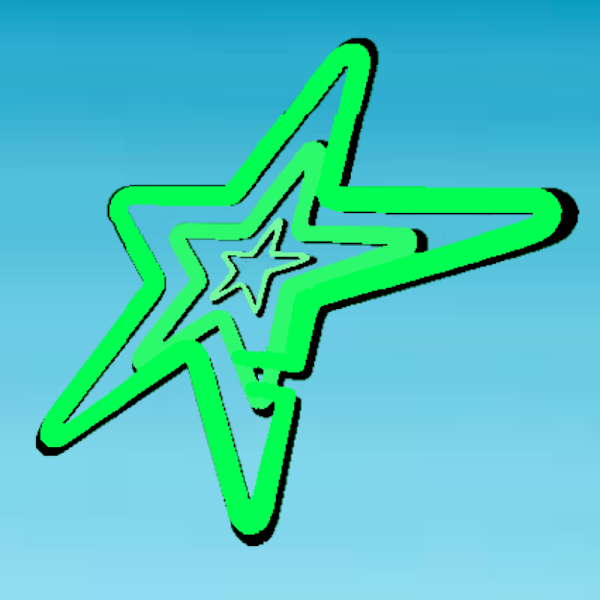
5 Yrs♥✓#
Beat the next game on my mainline Super Mario completion journey. I have played other NSMB games, but this is the first one I've beaten and it's exactly as mediocre as I thought it would be.
July 19th - New Super Mario Bros. - 16h 40m - 5/10 (100%) - Started July 13th - 6 Days Taken - Got 3 stars on save file by beating all levels, collecting all star coins and unlocking all secret exits.
Here's my review:
Pros:
New Super Mario Bros. (DS) has a decent amount of creativity despite being a NSMB game. Some levels have completely unique themes while quite a few have enemies that don't reappear. I also liked how the later worlds mixed and matched themes. They had levels that combined the current world's theme with a previous one. One aspect that surprised me was that the first castle in world 8 is a fakeout and only halfway through the world. Although I should've seen it coming, given how weird it would've been for the last world to be shorter than the rest.
The secret exits and star coins provide some nice additional difficulty for those who seek it out. I almost ran out of lives at one point, which I wasn't expecting would happen going in.
Neutral:
The boss of each world also ties into the theme of that world (most of the time) which more than I can say for the other NSMB games. Not that the bosses are memorable at all though, as they're still pretty generic.
The mini mushroom is used a lot for specific star coins and secret exits. It's a fun power up to use and you it makes most levels a lot easier. The problem is that you die in one hit with it. So if you're trying to get a star coins or secret exit you either have to keep retrying at one of the road houses until you get one or replaying a level that has an item box with the mini mushroom. Both waste a lot of your time, especially if the level that requires the mini mushroom is difficult. The only other option is save scumming which is what I ended up doing.
Cons:
Speaking of saving, I find it weird how the game doesn't let you save manually until after you beat the game. That could've been to prevent save scumming, but in that case they should've at least made it so that the game saves after every level, instead of only after every castle or tower. The only other way to save is to open an alternate path by spending star coins. However those are limited, so if you're not resourceful you could end up in situation where you have no way to save your progress for a while.
The other new power up in this game is the blue shell which I didn't find very fun to use. A lot of the time it was a detriment rather than a benefit. This is because if you run for long enough, you automatically go into shell mode, and if you're not laser focused on Mario he can easily and quickly bounce on a wall and fall into a pit.
The main antagonist of the game is technically Bowser junior as he's the one who kidnapped Peach, which is the reason why he is the mini boss in every tower level. But this just adds to the game's blandness and it doesn't help they he's pathetically easy.
The final boss consists of a big Bowser and Bowser Jr. Bowser Jr. is a joke and Bowser you can just run underneath. I was expecting something a little more challenging for the final boss. A surprise third phase could've helped it a lot.
July 19th - New Super Mario Bros. - 16h 40m - 5/10 (100%) - Started July 13th - 6 Days Taken - Got 3 stars on save file by beating all levels, collecting all star coins and unlocking all secret exits.
Here's my review:
Pros:
New Super Mario Bros. (DS) has a decent amount of creativity despite being a NSMB game. Some levels have completely unique themes while quite a few have enemies that don't reappear. I also liked how the later worlds mixed and matched themes. They had levels that combined the current world's theme with a previous one. One aspect that surprised me was that the first castle in world 8 is a fakeout and only halfway through the world. Although I should've seen it coming, given how weird it would've been for the last world to be shorter than the rest.
The secret exits and star coins provide some nice additional difficulty for those who seek it out. I almost ran out of lives at one point, which I wasn't expecting would happen going in.
Neutral:
The boss of each world also ties into the theme of that world (most of the time) which more than I can say for the other NSMB games. Not that the bosses are memorable at all though, as they're still pretty generic.
The mini mushroom is used a lot for specific star coins and secret exits. It's a fun power up to use and you it makes most levels a lot easier. The problem is that you die in one hit with it. So if you're trying to get a star coins or secret exit you either have to keep retrying at one of the road houses until you get one or replaying a level that has an item box with the mini mushroom. Both waste a lot of your time, especially if the level that requires the mini mushroom is difficult. The only other option is save scumming which is what I ended up doing.
Cons:
Speaking of saving, I find it weird how the game doesn't let you save manually until after you beat the game. That could've been to prevent save scumming, but in that case they should've at least made it so that the game saves after every level, instead of only after every castle or tower. The only other way to save is to open an alternate path by spending star coins. However those are limited, so if you're not resourceful you could end up in situation where you have no way to save your progress for a while.
The other new power up in this game is the blue shell which I didn't find very fun to use. A lot of the time it was a detriment rather than a benefit. This is because if you run for long enough, you automatically go into shell mode, and if you're not laser focused on Mario he can easily and quickly bounce on a wall and fall into a pit.
The main antagonist of the game is technically Bowser junior as he's the one who kidnapped Peach, which is the reason why he is the mini boss in every tower level. But this just adds to the game's blandness and it doesn't help they he's pathetically easy.
The final boss consists of a big Bowser and Bowser Jr. Bowser Jr. is a joke and Bowser you can just run underneath. I was expecting something a little more challenging for the final boss. A surprise third phase could've helped it a lot.
5 Yrs♥✓#
GreenStarfish
5 Yrs♥✓#
Fortnite Chapter 6 Season 3 Super is going to end in a couple days and I've played my last match of the season so here's my review.
August 2nd - Fortnite Ch6 S3: Super - 48h 53m - 9/10 - Reached level 155
Pros:
The best part of Ch6 S3 was definitely the battle pass. The theming was top-tier, every Fortnite original skin fit perfectly and even the collabs worked well and it made sense as to why they were there. If it was merely this, I wouldn't be celebrating it this much. It's because Epic went above and beyond with this season's battle pass. The Fortnite original skins appeared in each other's loading screens, extra loading screens released throughout the season and even a full promotional advertisement. This made it feel like they had a real sense of comradery, unlike many past battle pass groups. The season's story was also built around the battle pass characters while still including the chapter's storyline characters. The Fortnite original battle pass characters are students of the newly established Supernova Academy. This is so they can improve their skills with the superpowers they received from the spirit portal energy blast at the end of the Death Star event last season. The collab characters in the battle pass, Superman and Robin have been recruited to teach and help the students hone their superpowers. Even with stronger battle passes, there are usually some skins that get the shorter end of the stick, they are still in this battle pass but to a much lesser extent than usual. (I'll get back to this later.) This is because every skin was given a clearly defined personality with strengths and flaws, which made them feel like actual characters, rather than just skins made to fill battle pass spots.
Usually I don't have much to say about the design of the new battle pass skins because most new skins don't appeal to me and I'm sure that somebody out there will be a fan of it. I just stick to my main skins and don't even bother using the new skins, because I know I won't like them as much as my staples. However this time around I had the rare occurrence of finding a skin worthy of joining my main squad. The skin is Haylee Skye, the cheerleader whose superpower is to turn into a storm beast.
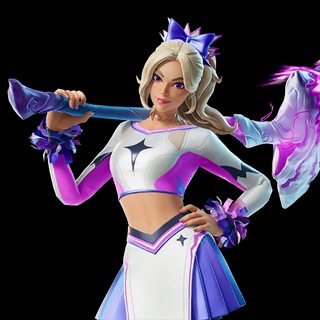
The reason why she joined the main squad should be obvious, but it's because of the hair physics. It's shorter than for all my other main skins and there's only one ponytail, but Epic must've cooked somehow because the strands within the ponytail make it super dynamic during gameplay. Pretty much exactly the type of physics I was hoping for from Shadow Blade Hope, whose hair felt like one big block, which limited the dynamicity and was also a bit too short.
I created this nice image to illustrate what my current main skin squad looks like.
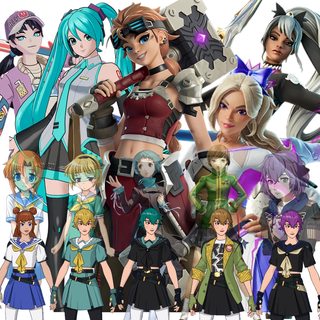
The gameplay was also tied into the battle pass, where each character's superpower (with the exception of Ziggy who doesn't really have one) was represented by an item in the loot pool. Every item was unique and had it's own use case, such that there was always a decision to be made about what do you prefer. For mobility, do you take the bass boost or the surf cube? One can shockwave other players away from you and damage structures, while the other has better mobility but no damage potential. Or instead of either those you could take the tracking visor as a utility item and know exactly where your opponents are at all times, but at the cost of not being able to quickly reposition yourself when shot at. This same type of trade off applies to the combat focused superpowers such as the myst gauntlets and storm beast's pom poms. I was always choosing a different superpower depending on what I felt like and one didn't feel OP compared to the others.
S3 also introduced other non-superpower weapons such as the hyperburst pistol and the spire rifle. I enjoy using both of them, which is quite surprising considering most of the time I prefer using the SMGs instead. The last time I preferred a pistol over an SMG was al the way back in Ch4 S1, with the tactical pistol.
Let's move away from Battle Royale for a second to discuss the new game mode that Epic added during this season, Blitz Royale or Blitz for short. The mode's premise is very short matches around 5 minutes in length. It was designed for mobile so you could play Fortnite while you're not occupied for a short while, like a lunch break for instance. It has a huge loot pool and a bunch of weapons and medallions that were previously exclusive to specific seasons. It does cater to the modern audience of short attention spans and constant dopamine hits through mostly being filled with bots and being much easier to get wins than regular BR. But honestly, sometimes that's what you need after a long day. It's fun to play a couple quick matches and get some easy wins, especially when you're not the best Fortnite player like myself. (This season it took me 8 days until the end of the season to finally get a win.) The mode also gets weekly updates with a new set of weapons based around a specific theme, which keeps it fresh and provides a reason to keep returning to the mode.
Super is also the shortest regular season since Ch1 S1! I've always preferred short and sweet season's to long drawn out ones, so it was nice to see how refreshingly short this season is.
The map updates this season were also pretty good. Daigo used his demonic powers to convert Masked Meadows into Demon's Domain and created spires that drained energy from the island so he could let the dark presence onto the island. Funded by Midas, Hope, Night Rose and Jones, constructed Supernova Academy to train the Supernovas and in the mean time Seaport City was also upgraded to Utopia City. However my favourite map change this season was the way that Superman's location the Fortress of Solitude was introduced. Epic could've very easily plopped it on the map for the Superman update, but instead they slowly built it up, without us knowing what they were doing. First The snow on the southern side of the map expanded and a new landmark, Lakeside Lab was added. Then a small glacier crashed into that same area. Only after that, did the Fortress of Solitude appear there.

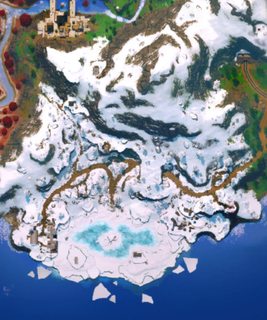
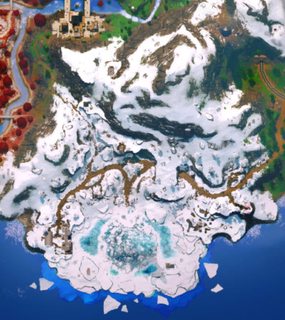
The storyline felt like it had a lot of depth this season with multiple layers to it, plus a tinge of a darker tone. It had us helping Morgan Myst improve her superpower skills, while also uncovering what was going on with Daigo and what connections Midas had to the academy. The storyline this chapter has been trending in a great direction, with amazing continuity (excluding Galactic Battle because it's a collab season) and continued use of characters from past seasons. This has likely been because Epic hired a new main storyline writer, Steve Danuser last November, which was only recently revealed. He's also worked on World of Warcraft and so far I have to commend him for doing a great job, hopefully this trend keeps on going in the right direction.
Neutral:
The climax of this season's storyline was the Super Showdown event near the end of the season, which I enjoyed a good amount. During the event Daigo opened a portal to let a part of the Dark Presence onto the island, which took the shape of a tentacle. The Supernovas got together to fight it, which meant that them building up to work as a team throughout the season had pay off. The event wasn't perfect though and had multiple areas where it could've been improved. The first is that more voice acting could've made the event so much better, imagine if we actually heard the Supernovas working together. The second is that Superman came in to save the day at the end of the event by oneshotting 3 of the Dark Presence's tentacles and then destroying the spires that kept the portal open. It felt cheap. Why didn't he do that at the start of the season? During the event there were comic book cut ins for Synthwave, Killswitch and Morgan Myst doing cool attacks against the Dark Presence. However Superman coming into save the day, snubbed the other 4 Supernova members from getting the same treatment. It would've also felt way more rewarding if the Supernovas defeated the remaining tentacles themselves, like they had truly learned to work together as a team. You could still have had the obligatory paid collaboration show up by having Superman come to destroy the spires, to close the portal.
OG S4 also launched and will end on the same day as Ch6 S3. I played a couple matches, but the old gunplay makes it take too long to kill someone and yet you die very quickly. It reminds me as to why I didn't play much Fortnite back in the day. Although Epic did revert the storm circle changes they made to OG in S1, which made matches way too long and drawn out. I have yet to play with the new storm circles, but I hope that it made OG a more enjoyable experience.
Alongside Blitz Royale, Fortnite also added Lego Expeditions which is a PvE mode in the Lego art style. I don't care about the Lego modes, so I haven't bothered playing it. If it wasn't using the Lego art style, I might've given the mode a shot.
Cons:
This year the summer event was the 14 Days of Summer event, which is the same name as the summer event from 2019. The event's premise is that every day a weapon got unvaulted for that day only. The next day a different would be unvaulted. However, there is a big difference between the 2019 event and the more recent one, which is that in that event, a new LTM was also added which would also be available for only one day. This made that old event a lot more interesting than the one we got this year, although they did choose some fun items to unvault like the grapple glove, shockwave hammer and balloons. Despite being an inferior version of a previous event, this event was also disappointing in another way, which is lack of free cosmetics. The event only gave out 4 cosmetics which is even lower than last year. For refence the original 14 Days of Summer event gave out 15 cosmetics. The worst part is that, it's not that Epic forgot how to do good events, because this chapter's winter event was amazing, no it's that they deliberately choose to put very little into the summer events for some reason.
Stats:
My stats somehow keep getting worse season over season, not that I really care, as long as I'm having fun. The win stats are wrong as I only got one win this season and I think the reason why is because it erroneously counted Blitz wins as BR wins. This is backed up by the fact that I got the BR win umbrella from winning a Blitz match for some reason.
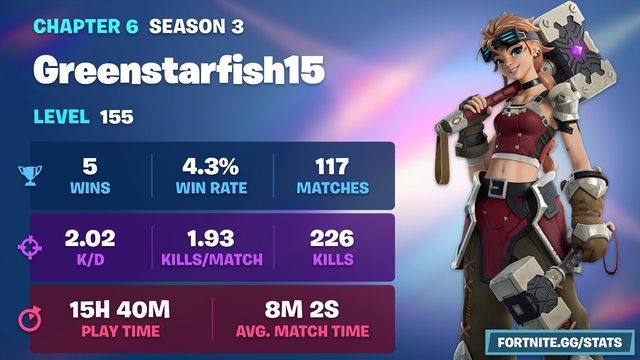
I only used my mains this season because I was using my new main skin most of the time. There's definitely a honeymoon-esque bias when I find a new skin.
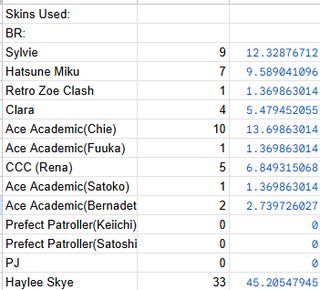
I didn't find any favorite drop spots this season, but I did land at Pumped Power so I could quickly get quests done at Supernova Academy without having to deal with sweats landing there, which is a POI I barely landed at before. It also had a Haylee Skye NPC, which was a nice bonus.
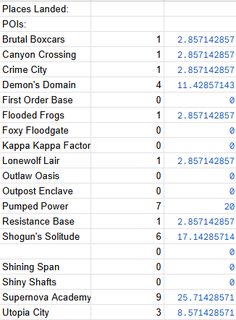
Aside from the best landmark, Pumpin' Pipes, I also landed at the new landmark Pickles and Paddles a good amount, because it was an uncontested spot near Demon's Domain.
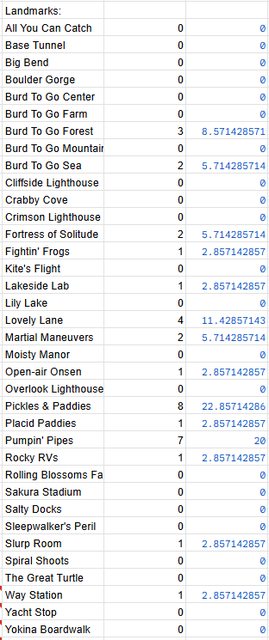
A more balanced spread than usual because I had to play Festival for a bit because my mouse broke and it took a bit to get a new one. Also played less RR than I usually do, only got to Diamond II, this season. Maybe the lack of RR content is finally starting to affect me.
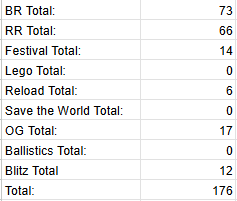
I thoroughly enjoyed Ch6 S3, one of the best seasons we've had in a long while. I really hope Epic can keep it up and make next season just as good.
August 2nd - Fortnite Ch6 S3: Super - 48h 53m - 9/10 - Reached level 155
Pros:
The best part of Ch6 S3 was definitely the battle pass. The theming was top-tier, every Fortnite original skin fit perfectly and even the collabs worked well and it made sense as to why they were there. If it was merely this, I wouldn't be celebrating it this much. It's because Epic went above and beyond with this season's battle pass. The Fortnite original skins appeared in each other's loading screens, extra loading screens released throughout the season and even a full promotional advertisement. This made it feel like they had a real sense of comradery, unlike many past battle pass groups. The season's story was also built around the battle pass characters while still including the chapter's storyline characters. The Fortnite original battle pass characters are students of the newly established Supernova Academy. This is so they can improve their skills with the superpowers they received from the spirit portal energy blast at the end of the Death Star event last season. The collab characters in the battle pass, Superman and Robin have been recruited to teach and help the students hone their superpowers. Even with stronger battle passes, there are usually some skins that get the shorter end of the stick, they are still in this battle pass but to a much lesser extent than usual. (I'll get back to this later.) This is because every skin was given a clearly defined personality with strengths and flaws, which made them feel like actual characters, rather than just skins made to fill battle pass spots.
Usually I don't have much to say about the design of the new battle pass skins because most new skins don't appeal to me and I'm sure that somebody out there will be a fan of it. I just stick to my main skins and don't even bother using the new skins, because I know I won't like them as much as my staples. However this time around I had the rare occurrence of finding a skin worthy of joining my main squad. The skin is Haylee Skye, the cheerleader whose superpower is to turn into a storm beast.

The reason why she joined the main squad should be obvious, but it's because of the hair physics. It's shorter than for all my other main skins and there's only one ponytail, but Epic must've cooked somehow because the strands within the ponytail make it super dynamic during gameplay. Pretty much exactly the type of physics I was hoping for from Shadow Blade Hope, whose hair felt like one big block, which limited the dynamicity and was also a bit too short.
I created this nice image to illustrate what my current main skin squad looks like.

The gameplay was also tied into the battle pass, where each character's superpower (with the exception of Ziggy who doesn't really have one) was represented by an item in the loot pool. Every item was unique and had it's own use case, such that there was always a decision to be made about what do you prefer. For mobility, do you take the bass boost or the surf cube? One can shockwave other players away from you and damage structures, while the other has better mobility but no damage potential. Or instead of either those you could take the tracking visor as a utility item and know exactly where your opponents are at all times, but at the cost of not being able to quickly reposition yourself when shot at. This same type of trade off applies to the combat focused superpowers such as the myst gauntlets and storm beast's pom poms. I was always choosing a different superpower depending on what I felt like and one didn't feel OP compared to the others.
S3 also introduced other non-superpower weapons such as the hyperburst pistol and the spire rifle. I enjoy using both of them, which is quite surprising considering most of the time I prefer using the SMGs instead. The last time I preferred a pistol over an SMG was al the way back in Ch4 S1, with the tactical pistol.
Let's move away from Battle Royale for a second to discuss the new game mode that Epic added during this season, Blitz Royale or Blitz for short. The mode's premise is very short matches around 5 minutes in length. It was designed for mobile so you could play Fortnite while you're not occupied for a short while, like a lunch break for instance. It has a huge loot pool and a bunch of weapons and medallions that were previously exclusive to specific seasons. It does cater to the modern audience of short attention spans and constant dopamine hits through mostly being filled with bots and being much easier to get wins than regular BR. But honestly, sometimes that's what you need after a long day. It's fun to play a couple quick matches and get some easy wins, especially when you're not the best Fortnite player like myself. (This season it took me 8 days until the end of the season to finally get a win.) The mode also gets weekly updates with a new set of weapons based around a specific theme, which keeps it fresh and provides a reason to keep returning to the mode.
Super is also the shortest regular season since Ch1 S1! I've always preferred short and sweet season's to long drawn out ones, so it was nice to see how refreshingly short this season is.
The map updates this season were also pretty good. Daigo used his demonic powers to convert Masked Meadows into Demon's Domain and created spires that drained energy from the island so he could let the dark presence onto the island. Funded by Midas, Hope, Night Rose and Jones, constructed Supernova Academy to train the Supernovas and in the mean time Seaport City was also upgraded to Utopia City. However my favourite map change this season was the way that Superman's location the Fortress of Solitude was introduced. Epic could've very easily plopped it on the map for the Superman update, but instead they slowly built it up, without us knowing what they were doing. First The snow on the southern side of the map expanded and a new landmark, Lakeside Lab was added. Then a small glacier crashed into that same area. Only after that, did the Fortress of Solitude appear there.



The storyline felt like it had a lot of depth this season with multiple layers to it, plus a tinge of a darker tone. It had us helping Morgan Myst improve her superpower skills, while also uncovering what was going on with Daigo and what connections Midas had to the academy. The storyline this chapter has been trending in a great direction, with amazing continuity (excluding Galactic Battle because it's a collab season) and continued use of characters from past seasons. This has likely been because Epic hired a new main storyline writer, Steve Danuser last November, which was only recently revealed. He's also worked on World of Warcraft and so far I have to commend him for doing a great job, hopefully this trend keeps on going in the right direction.
Neutral:
The climax of this season's storyline was the Super Showdown event near the end of the season, which I enjoyed a good amount. During the event Daigo opened a portal to let a part of the Dark Presence onto the island, which took the shape of a tentacle. The Supernovas got together to fight it, which meant that them building up to work as a team throughout the season had pay off. The event wasn't perfect though and had multiple areas where it could've been improved. The first is that more voice acting could've made the event so much better, imagine if we actually heard the Supernovas working together. The second is that Superman came in to save the day at the end of the event by oneshotting 3 of the Dark Presence's tentacles and then destroying the spires that kept the portal open. It felt cheap. Why didn't he do that at the start of the season? During the event there were comic book cut ins for Synthwave, Killswitch and Morgan Myst doing cool attacks against the Dark Presence. However Superman coming into save the day, snubbed the other 4 Supernova members from getting the same treatment. It would've also felt way more rewarding if the Supernovas defeated the remaining tentacles themselves, like they had truly learned to work together as a team. You could still have had the obligatory paid collaboration show up by having Superman come to destroy the spires, to close the portal.
OG S4 also launched and will end on the same day as Ch6 S3. I played a couple matches, but the old gunplay makes it take too long to kill someone and yet you die very quickly. It reminds me as to why I didn't play much Fortnite back in the day. Although Epic did revert the storm circle changes they made to OG in S1, which made matches way too long and drawn out. I have yet to play with the new storm circles, but I hope that it made OG a more enjoyable experience.
Alongside Blitz Royale, Fortnite also added Lego Expeditions which is a PvE mode in the Lego art style. I don't care about the Lego modes, so I haven't bothered playing it. If it wasn't using the Lego art style, I might've given the mode a shot.
Cons:
This year the summer event was the 14 Days of Summer event, which is the same name as the summer event from 2019. The event's premise is that every day a weapon got unvaulted for that day only. The next day a different would be unvaulted. However, there is a big difference between the 2019 event and the more recent one, which is that in that event, a new LTM was also added which would also be available for only one day. This made that old event a lot more interesting than the one we got this year, although they did choose some fun items to unvault like the grapple glove, shockwave hammer and balloons. Despite being an inferior version of a previous event, this event was also disappointing in another way, which is lack of free cosmetics. The event only gave out 4 cosmetics which is even lower than last year. For refence the original 14 Days of Summer event gave out 15 cosmetics. The worst part is that, it's not that Epic forgot how to do good events, because this chapter's winter event was amazing, no it's that they deliberately choose to put very little into the summer events for some reason.
Stats:
My stats somehow keep getting worse season over season, not that I really care, as long as I'm having fun. The win stats are wrong as I only got one win this season and I think the reason why is because it erroneously counted Blitz wins as BR wins. This is backed up by the fact that I got the BR win umbrella from winning a Blitz match for some reason.

I only used my mains this season because I was using my new main skin most of the time. There's definitely a honeymoon-esque bias when I find a new skin.

I didn't find any favorite drop spots this season, but I did land at Pumped Power so I could quickly get quests done at Supernova Academy without having to deal with sweats landing there, which is a POI I barely landed at before. It also had a Haylee Skye NPC, which was a nice bonus.

Aside from the best landmark, Pumpin' Pipes, I also landed at the new landmark Pickles and Paddles a good amount, because it was an uncontested spot near Demon's Domain.

A more balanced spread than usual because I had to play Festival for a bit because my mouse broke and it took a bit to get a new one. Also played less RR than I usually do, only got to Diamond II, this season. Maybe the lack of RR content is finally starting to affect me.

I thoroughly enjoyed Ch6 S3, one of the best seasons we've had in a long while. I really hope Epic can keep it up and make next season just as good.
5 Yrs♥✓#
GreenStarfish
5 Yrs♥✓#
Finished the Episode Aigis DLC for Persona 3 Reload right before it left Xbox game pass. I didn't actually take 328 days to finish it, 99% of my playthrough was within the span of 8 days. I started it in September of last year because that's when I was originally going to play the DLC, but I made a deal with my brother that he would first finish his P4G replay. I'm still waiting on him to do that, the only reason I played this game now was out of necessity. If P3R wasn't leaving game pass, I would've waited however long it took for my brother to finish his playthrough. Either way, I definitely think Episode Aigis is a bit overhated within the Persona community, it's not nearly as bad as what I'd heard from others.
August 16th - Persona 3 Reload - Episode Aigis: The Answer - 44h 20m - 7/10 - Main+ - Started September 22nd 2024 - 328 Days Taken - Beat the dlc, did all Elizabeth requests, completed 94% of the compendium and did two bosses in the Monad Chamber.
Here's my review:
Pros:
Episode Aigis's story is about how people deal with grief and how to move past it. It provides a new angle for P3s theme to explore and compliments the main game's story well. The DLC has the Abyss of Time keep SEES stuck in a time loop, repeating March 31st over and over until they can deal with whatever is holding them back. As you progress through the doors, you see flashes of the party members pasts, specifically the moment that caused them to awaken to their potential. It forces them to reflect on their past and from that, Metis (a new character in Episode Aigis) figures out what's really holding SEES back. It's that they're stuck in the past and unable to deal with and move on from the P3 protagonist's death. (Who will hence forth be referred to by his canon name Makoto.) SEES is quite literally being held back until they deal with those repressed thoughts.
Once that's revealed, the DLC moves to showing how people deal with that grief. Some are ready to move on, but Yukari and Mitsuru need more convincing. The Abyss of Time would allow them to go back in time and potentially save Makoto's life. This leads to one of the coolest segments in the DLC which is where you fight your party members in 2v2 matches. (More RPGs should do something like this.)
I did get spoiled on the last part of the story, which is what happened to Makoto at the end of the base game. The answer is that he became a seal, preventing Nyx from reawakening due to the will of mankind. Even though I got spoiled on it, it wasn't too bad since you could have already inferred it from the fact that the move you use against Nyx in the final battle of P3 is called Nyx Seal.
What I didn't get spoiled on was the plot twist related to Metis, which is that she's actually a part of Aigis that split apart. It happened because she wished to be a robot again due to the grief she was going through from Makoto's death. Aigis took the more robotic elements while Metis took the emotional half. You see this throughout the DLC as Metis is shown to be a very emotional character. The plot twist is also foreshadowed well in the cutscene where Aigis chases after Makoto. You see Metis's shadow rise from Aigis's body after she wishes to be a robot again.
Neutral:
Moving onto the gameplay. I played all of Episode Aigis on hard difficulty, compared to the normal I played the base game on. The difficulty was pretty well balanced, which is surprising for a Persona game. The problem that Persona difficulty suffers from is that the difficulty curve is inversed to some extent. It's hardest in the beginning when you have the fewest options available to you and gets easier once those options unlock. However despite those flaws, I still had to play skillfully and having a party member go down or even a game over was never out of the realm of possibility. The optional superboss content was also fittingly difficult, although I didn't manage to finish all of it.
Returning to the plot point about what is causing the Abyss of Time, it suffers from similar pacing issues as P3s main story. The plot point is spread out throughout most of the DLC and you only find out the cause near the end, once you reach the last door of time. This means that for a majority of your playtime you're seeing the flashbacks without any idea of how they're related to the main plot. There's no meaningful progression until you reach the penultimate door of time, which makes the time spent to reach them feel less rewarding. Speaking of what it takes to reach those doors...
Cons:
My main gripe with Episode Aigis is that a majority of the DLC is just Persona with the daily life management ripped out, leaving only the dungeon combat. Persona is unique, because it balances these two very different halves of the game and it's one of the things I like a lot about Persona. For 90% of the DLC you're just running through Tartarus with a different coat of paint. I already wasn't a fan of Tartarus compared to the dungeons and palaces in P4 and P5 due to the lack of unique theming and repetitiveness. It also doesn't help that the music isn't interesting whatsoever compared to the dungeon music from the later games. The Abyss of Time shares all the same qualities that Tartarus has, except it fails even harder. Each block of Tartarus has a unique theme, meanwhile the Abyss of Time repeats them. It would've been much better if each Door of Time had its own unique theming that fit the character whose flashback it contained.
Another odd choice is to not have a gatekeeper at the end of each Door of Time. The design choice made sense in Tartarus, because they weren't the main bosses you faced during the game. However, in Episode Aigis, the Abyss of Time gatekeepers are the only bosses you fight until the very end of the DLC. It felt redundant to trek through multiple floors after beating the last gatekeeper of a block, so you could reach the Door of Time. It would've been much more rewarding if the Door of Time was directly after the last gatekeeper. The fact that the DLC is almost entirely gameplay with little in between, could've resorted in a tedious and boring experience. However, Persona combat is very fun, so it never reached those levels for me, especially because of the higher difficulty I played the DLC at.
August 16th - Persona 3 Reload - Episode Aigis: The Answer - 44h 20m - 7/10 - Main+ - Started September 22nd 2024 - 328 Days Taken - Beat the dlc, did all Elizabeth requests, completed 94% of the compendium and did two bosses in the Monad Chamber.
Here's my review:
Pros:
Episode Aigis's story is about how people deal with grief and how to move past it. It provides a new angle for P3s theme to explore and compliments the main game's story well. The DLC has the Abyss of Time keep SEES stuck in a time loop, repeating March 31st over and over until they can deal with whatever is holding them back. As you progress through the doors, you see flashes of the party members pasts, specifically the moment that caused them to awaken to their potential. It forces them to reflect on their past and from that, Metis (a new character in Episode Aigis) figures out what's really holding SEES back. It's that they're stuck in the past and unable to deal with and move on from the P3 protagonist's death. (Who will hence forth be referred to by his canon name Makoto.) SEES is quite literally being held back until they deal with those repressed thoughts.
Once that's revealed, the DLC moves to showing how people deal with that grief. Some are ready to move on, but Yukari and Mitsuru need more convincing. The Abyss of Time would allow them to go back in time and potentially save Makoto's life. This leads to one of the coolest segments in the DLC which is where you fight your party members in 2v2 matches. (More RPGs should do something like this.)
I did get spoiled on the last part of the story, which is what happened to Makoto at the end of the base game. The answer is that he became a seal, preventing Nyx from reawakening due to the will of mankind. Even though I got spoiled on it, it wasn't too bad since you could have already inferred it from the fact that the move you use against Nyx in the final battle of P3 is called Nyx Seal.
What I didn't get spoiled on was the plot twist related to Metis, which is that she's actually a part of Aigis that split apart. It happened because she wished to be a robot again due to the grief she was going through from Makoto's death. Aigis took the more robotic elements while Metis took the emotional half. You see this throughout the DLC as Metis is shown to be a very emotional character. The plot twist is also foreshadowed well in the cutscene where Aigis chases after Makoto. You see Metis's shadow rise from Aigis's body after she wishes to be a robot again.
Neutral:
Moving onto the gameplay. I played all of Episode Aigis on hard difficulty, compared to the normal I played the base game on. The difficulty was pretty well balanced, which is surprising for a Persona game. The problem that Persona difficulty suffers from is that the difficulty curve is inversed to some extent. It's hardest in the beginning when you have the fewest options available to you and gets easier once those options unlock. However despite those flaws, I still had to play skillfully and having a party member go down or even a game over was never out of the realm of possibility. The optional superboss content was also fittingly difficult, although I didn't manage to finish all of it.
Returning to the plot point about what is causing the Abyss of Time, it suffers from similar pacing issues as P3s main story. The plot point is spread out throughout most of the DLC and you only find out the cause near the end, once you reach the last door of time. This means that for a majority of your playtime you're seeing the flashbacks without any idea of how they're related to the main plot. There's no meaningful progression until you reach the penultimate door of time, which makes the time spent to reach them feel less rewarding. Speaking of what it takes to reach those doors...
Cons:
My main gripe with Episode Aigis is that a majority of the DLC is just Persona with the daily life management ripped out, leaving only the dungeon combat. Persona is unique, because it balances these two very different halves of the game and it's one of the things I like a lot about Persona. For 90% of the DLC you're just running through Tartarus with a different coat of paint. I already wasn't a fan of Tartarus compared to the dungeons and palaces in P4 and P5 due to the lack of unique theming and repetitiveness. It also doesn't help that the music isn't interesting whatsoever compared to the dungeon music from the later games. The Abyss of Time shares all the same qualities that Tartarus has, except it fails even harder. Each block of Tartarus has a unique theme, meanwhile the Abyss of Time repeats them. It would've been much better if each Door of Time had its own unique theming that fit the character whose flashback it contained.
Another odd choice is to not have a gatekeeper at the end of each Door of Time. The design choice made sense in Tartarus, because they weren't the main bosses you faced during the game. However, in Episode Aigis, the Abyss of Time gatekeepers are the only bosses you fight until the very end of the DLC. It felt redundant to trek through multiple floors after beating the last gatekeeper of a block, so you could reach the Door of Time. It would've been much more rewarding if the Door of Time was directly after the last gatekeeper. The fact that the DLC is almost entirely gameplay with little in between, could've resorted in a tedious and boring experience. However, Persona combat is very fun, so it never reached those levels for me, especially because of the higher difficulty I played the DLC at.
5 Yrs♥✓#
GreenStarfish
5 Yrs♥✓#
This is my 500th post on the HLTB forums and for it I wanted to do something special. (Technically the 501st because I made a blunder.) This year also marks 5 years that I've been on HTLB, (very coincidentally yesterday was also the one year anniversary since I created this blog) and I want to celebrate that. Because HLTB has the best and most positive gaming community I've found online. This goes for the forums as well as the Discord server. On the tracking side of things, it's been so good that I've never felt the need to find something better, I can't say the same thing for the movie/TV show and book tracking sites I use. On top of that the site is always improving, due to Everdred's effort and diligence to listening to the community's feedback. HLTB has impacted my life as well. If it wasn't for HLTB I don't think I would've ever started to review games, movies, TV shows or books. (Who knows, I might start to review more things in the future as well.) It helped me view the media I consume with a critical eye and form opinions for myself. To be specific, I joined HLTB on January 8th of 2020. It took a couple years, but in May 2024 I decided to take the plunge and start reviewing books and movies/tv shows as well. I joined Storygraph and Trakt on May 11th and 12th respectively.
To celebrate, I want to showcase some HLTB stats that aren't directly related to games, starting with the amount of forum posts I've made per year.
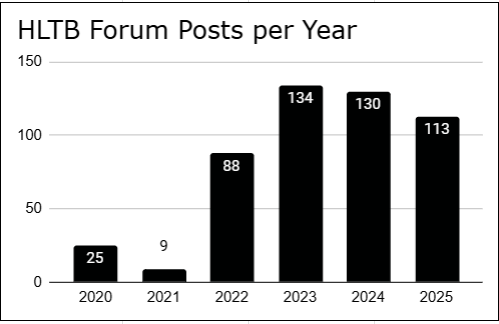
It took a couple years before I really got into the forums, the past two years it has gone down slightly, but the reason for that is because I have spent more time on the Discord server instead. I joined it on December 30th of 2024, but really only started actively talking there on May 4th of 2024.
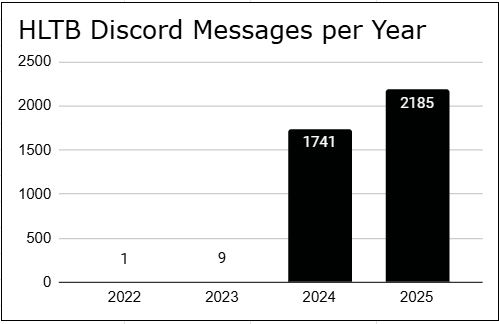
These days I review every game I beat, but it didn't start that way, I slowly developed that habit over time. The first game I reviewed was one I did retroactively which I beat before I created my HLTB account. It was Headliner, which I reviewed on December 19th of 2019. In the first year, I was only reviewing some of the games I beat, I have no idea why I was being selective about it. However that changed after my review of Game Dev Tycoon on December 22nd 2020, after which I've reviewed every game I've beaten since, with only a few special exceptions. The first book I reviewed was Assassin's Quest On June 18th 2024, about a month after I created my Storygraph account. My first movie/tv show review took until September 16th 2024 and it was a review of the first Ranma 1/2 movie, Big Trouble in Nekonron.
The reviews I write per year, depends on how many games, movies/tv shows and books I manage to consume in a year. However since I created this blog, I've also started to create reviews for games when I haven't strictly beaten them, like separate reviews for each arc of Higurashi and reviews for Fortnite seasons. In total I've written 157 game reviews, 29 movie/tv show reviews and 23 book reviews. The total number of reviews I've written is currently stands at 209.
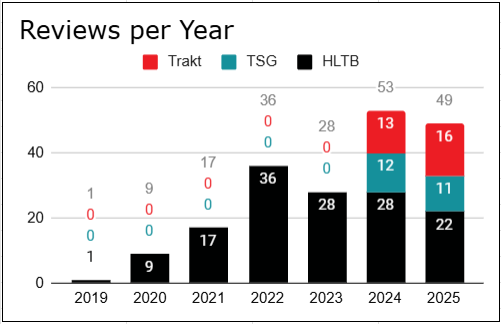
Recently I've also started to keep track of what my longest reviews, in general as well as per media type.
Games: Persona 4 Golden (956 words, 5218 characters) -> Higurashi: Tsumihoroboshi (1505 words, 8783 characters) -> Fortnite Ch6 S3: Super (1795 words, 9987 characters)
Movies/Shows: Ranma 1/2 2011 Live Action special (1444 words, 7966 characters) -> Squid Game S3 (1811 words, 9896 characters)
Books: Ranma 1/2 Volume 34 (1054 words, 5971 characters) -> Ranma 1/2 Volume 36 (1184 words, 6564 characters) -> Republic of Thieves (1396 words, 7782 characters)
I also checked what my longest review was for each year per category.
Longest Game Reviews each Year:
2019: Headliner (29 words, 157 characters) - A technicality, because it's also the only review I wrote that year.
2020: The Henry Stickmin Collection (217 words, 1156 characters)
2021: Phoenix Wright: Ace Attorney - Spirit of Justice (260 words, 1362 characters)
2022: Super Mario Bros. (427 words, 2285 characters)
2023: Super Mario 3D All-Stars (925 words, 4962 characters)
2024: Higurashi: Tsumihoroboshi (1505 words, 8783 characters)
2025: Fortnite Ch6 S3: Super (1795 words, 9987 characters)
Longest Book Reviews each Year:
2024: Ranma 1/2 Vol. 36 (1184 words, 6564 characters)
2025: Republic of Thieves (1396 words, 7782 characters)
Longest Movie Reviews each Year:
2024: Ranma 1/2 2011 Live Action special (1444 words, 7966 characters)
2025: Squid Game S3 (1811 words, 9896 characters)
I like pushing myself and seeing if I can break my record. The ones that end up doing it have been the ones I least expect, like the Ch6 S3 review. But it isn't only the record breaking reviews that have been increasing in length. I knew the average review length was increasing, but I didn't realize the rate it was increasing at. The first 5 years it was pretty consistent, growth at around 50 words per year. but after that, a switch must've flipped and the rate of increase quadrupled. I'm wondering when the length of my reviews will plateau.
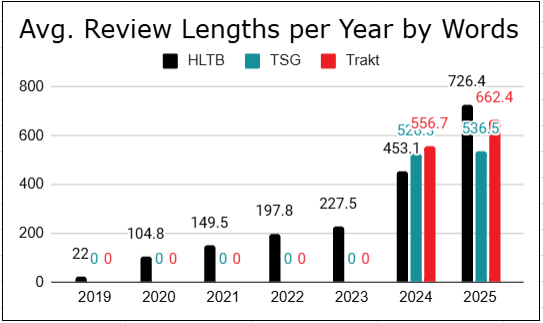
That's the last of the stats I wanted to share for this celebration. I've loved the 5 years I've spent in this community and here's to hoping that the next 5 years I spend in this community, will be just as positive and amazing.
To celebrate, I want to showcase some HLTB stats that aren't directly related to games, starting with the amount of forum posts I've made per year.

It took a couple years before I really got into the forums, the past two years it has gone down slightly, but the reason for that is because I have spent more time on the Discord server instead. I joined it on December 30th of 2024, but really only started actively talking there on May 4th of 2024.

These days I review every game I beat, but it didn't start that way, I slowly developed that habit over time. The first game I reviewed was one I did retroactively which I beat before I created my HLTB account. It was Headliner, which I reviewed on December 19th of 2019. In the first year, I was only reviewing some of the games I beat, I have no idea why I was being selective about it. However that changed after my review of Game Dev Tycoon on December 22nd 2020, after which I've reviewed every game I've beaten since, with only a few special exceptions. The first book I reviewed was Assassin's Quest On June 18th 2024, about a month after I created my Storygraph account. My first movie/tv show review took until September 16th 2024 and it was a review of the first Ranma 1/2 movie, Big Trouble in Nekonron.
The reviews I write per year, depends on how many games, movies/tv shows and books I manage to consume in a year. However since I created this blog, I've also started to create reviews for games when I haven't strictly beaten them, like separate reviews for each arc of Higurashi and reviews for Fortnite seasons. In total I've written 157 game reviews, 29 movie/tv show reviews and 23 book reviews. The total number of reviews I've written is currently stands at 209.

Recently I've also started to keep track of what my longest reviews, in general as well as per media type.
Games: Persona 4 Golden (956 words, 5218 characters) -> Higurashi: Tsumihoroboshi (1505 words, 8783 characters) -> Fortnite Ch6 S3: Super (1795 words, 9987 characters)
Movies/Shows: Ranma 1/2 2011 Live Action special (1444 words, 7966 characters) -> Squid Game S3 (1811 words, 9896 characters)
Books: Ranma 1/2 Volume 34 (1054 words, 5971 characters) -> Ranma 1/2 Volume 36 (1184 words, 6564 characters) -> Republic of Thieves (1396 words, 7782 characters)
I also checked what my longest review was for each year per category.
Longest Game Reviews each Year:
2019: Headliner (29 words, 157 characters) - A technicality, because it's also the only review I wrote that year.
2020: The Henry Stickmin Collection (217 words, 1156 characters)
2021: Phoenix Wright: Ace Attorney - Spirit of Justice (260 words, 1362 characters)
2022: Super Mario Bros. (427 words, 2285 characters)
2023: Super Mario 3D All-Stars (925 words, 4962 characters)
2024: Higurashi: Tsumihoroboshi (1505 words, 8783 characters)
2025: Fortnite Ch6 S3: Super (1795 words, 9987 characters)
Longest Book Reviews each Year:
2024: Ranma 1/2 Vol. 36 (1184 words, 6564 characters)
2025: Republic of Thieves (1396 words, 7782 characters)
Longest Movie Reviews each Year:
2024: Ranma 1/2 2011 Live Action special (1444 words, 7966 characters)
2025: Squid Game S3 (1811 words, 9896 characters)
I like pushing myself and seeing if I can break my record. The ones that end up doing it have been the ones I least expect, like the Ch6 S3 review. But it isn't only the record breaking reviews that have been increasing in length. I knew the average review length was increasing, but I didn't realize the rate it was increasing at. The first 5 years it was pretty consistent, growth at around 50 words per year. but after that, a switch must've flipped and the rate of increase quadrupled. I'm wondering when the length of my reviews will plateau.

That's the last of the stats I wanted to share for this celebration. I've loved the 5 years I've spent in this community and here's to hoping that the next 5 years I spend in this community, will be just as positive and amazing.

14 Yrs♥F✓#
Great post, really fun insights. Thanks for your contributions!
5 Yrs♥✓#
GreenStarfish
5 Yrs♥✓#
I wanted to make my 500th post before I wrote this review, so that's why this review is a bit late. Little Kitty Big City was better than I thought it would be for reasons which you'll soon find out.
September 5th - Little Kitty, Big City - 10h 7m - 8/10 - Main+ - Started August 22nd - 14 Days Taken - Beat the game, did all the quests, got 54/56 hats and got 82% of achievements.
Pros:
Out of the two games I've played where you play as a cat, Little Kitty Big City's stand out quality is that it leans much into the cat aspects of a game than Stray does. In Stray there are a few cat related things you do, like nap in some area, but other than that, you could replace the cat with another small agile animal like a monkey. The same principle can't be applied to Little Kitty Big City. Not only can you nap, but you aren't allowed to touch water, you need to eat fish to gain more energy and you can catch birds. There is even a dedicated emote button where you can perform cat actions on the spot, like stretching and sleeping. Stray is a game where you happen to play as a cat, while LKBC is a CAT game. The other cat mechanics the game implements, like climbing, make you feel like you're really playing like a cat, which is exactly what I'm looking for in a cat game. In Stray, you can only move and jump from predetermined points, meanwhile this game lets you jump and climb wherever your heart desires. It embraces the natural freedom you would expect a cat to have and it feels very rewarding when you pull off a tricky jump or climb.
The map is also well designed. In the beginning you are led through two smaller tutorial areas that teach you some of the game's key mechanics, after which it sets you free into the world to do whatever you want. The world feels like it's worth exploring due to the quests, hats, fish and napping spots scattered throughout the map. However, it doesn't fall into the trap of having a bunch of empty space between those collectibles as everything is still packed close together, due to the city setting. There are also plentiful fast travel points scattered about if you want to get somewhere quickly. Due to these factors, exploring the map is a joy and never feels like chore.
Partway through my playthrough the Picture Purrfect update came out and the customization feature it adds, improves the game tremendously. It allows you to recreate your own cat in the game, which makes the game feel much more personal. The creation system isn't perfect, I wish it had a couple more options, but overall it gets to job done well enough. The increased attachment you have towards the cat can also be made use of because of the new photo system. It allows you to snap pictures of your beautiful cat and it has a lot of options you can tinker with like filters and stickers. I had a lot of fun coming up with creative pictures I could take of my cat.
Little Kitty Big City's story is simple, you fall off your owner's windowsill, who lives at the top of an apartment building and your goal is to get back there. However, a simple story is all the game needs to give you concrete goal to work towards while letting the gameplay shine. There was one aspect of the story that really stood out to me though, which was the fact that you get to name the cat at the end of the game. You don't see it coming, because, usually when you name a main character, it's done at the beginning of the game. Throughout the entire game the cat has been referred to simply as Kitty and you don't expect that to change. The reason why you are given the option to name your character at the start of games is so you can roleplay better and build a stronger emotional attachment to the game and its characters because of that. But in Little Kitty Big City it still works because you're likely going to name it after one of your own cats, which you already have an emotional connection to. This connection is further strengthened by the new update because the cat you're naming will look like the one you're naming it after. This was especially effective for me, because the cat I recreated in the game was one that went missing 1.5 years ago (as of writing this) and it felt special to be able to immortalize her in digital form within the game. I was able to relive some of the joy I had with her through the game. I was able to take digital pictures of her that I can't take anymore IRL and I love that Little Kitty Big City gave me that avenue.
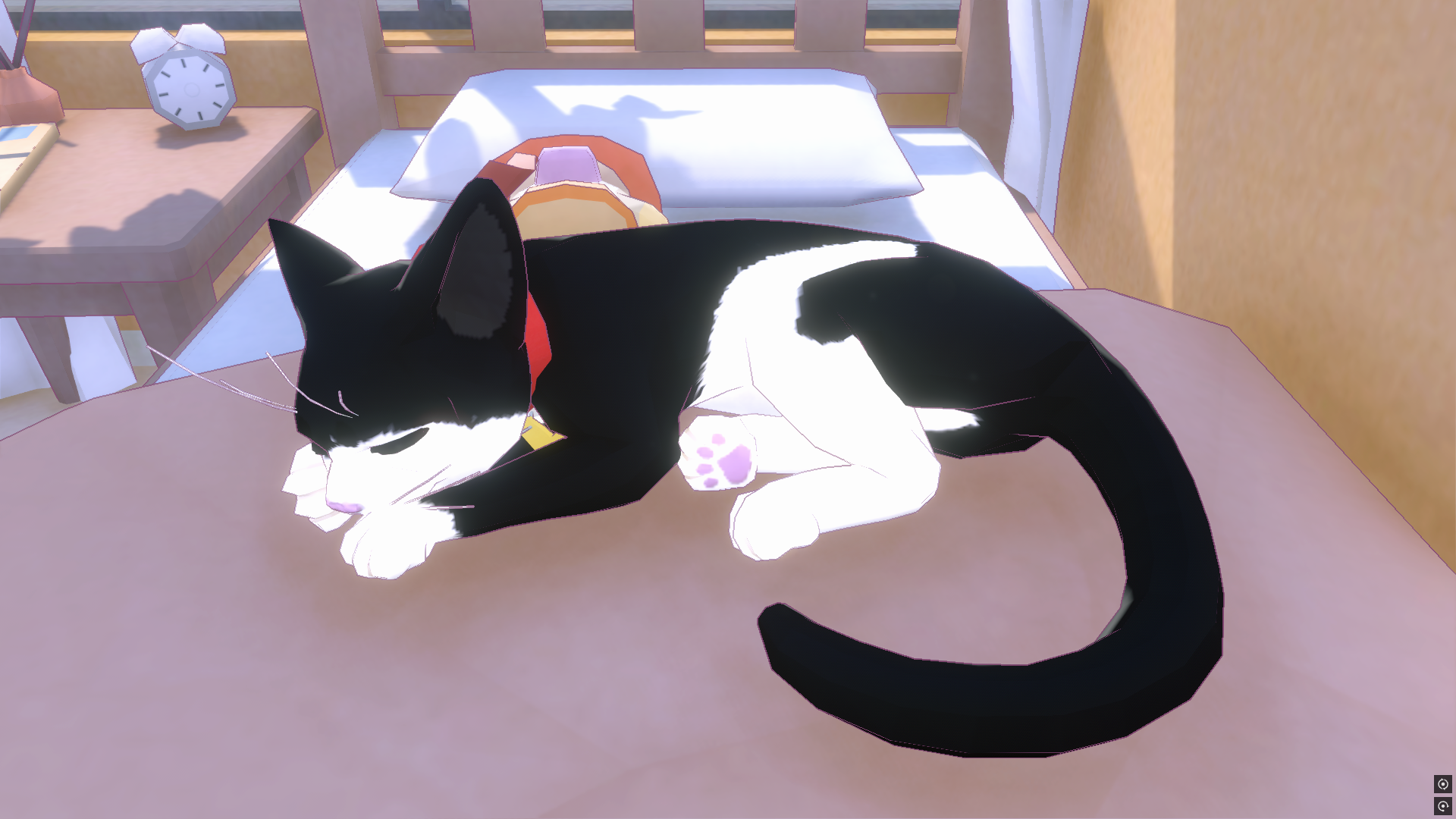
Neutral:
The game's humor and music are decent, but nothing out of the ordinary. The one exception would is Taffy's theme, which is one of the new themes added in the update. It stood out due to its use of lyrics.
Cons:
One small issue I had with Little Kitty Big City was one quest where I had to use a guide to figure it out due to the instructions not being clear enough. You had to find a specific location with a set of hints, one of which was that it was behind a yellow house. Except the house it was actually next to was more beige than yellow.
The bigger issue I noticed was the amount of bugs I encountered during my playthrough. Sometimes when you landed somewhere the movement would freak out a bit and place you in the wrong location. I also noticed one prop that was floating off the ground after I had interacted with it. One time a piece of ambient audio got stuck playing in the background, although it was very subtle so it took me a while to notice it was happening. The biggest issue I encountered was that I got softlocked after the movement bugged out and I was forced to reload a save. Luckily I had saved shortly beforehand, so it didn't affect my progress. These bugs aren't so plentiful that they completely ruin the game, in fact I only encountered them near the beginning of my playthrough. However they're still frequent enough
to be noticeable. It felt like the game could've used a bit more polish in the bug testing and QA department. It contrasts quite a bit with the other aspects of the game, which are well polished.
September 5th - Little Kitty, Big City - 10h 7m - 8/10 - Main+ - Started August 22nd - 14 Days Taken - Beat the game, did all the quests, got 54/56 hats and got 82% of achievements.
Pros:
Out of the two games I've played where you play as a cat, Little Kitty Big City's stand out quality is that it leans much into the cat aspects of a game than Stray does. In Stray there are a few cat related things you do, like nap in some area, but other than that, you could replace the cat with another small agile animal like a monkey. The same principle can't be applied to Little Kitty Big City. Not only can you nap, but you aren't allowed to touch water, you need to eat fish to gain more energy and you can catch birds. There is even a dedicated emote button where you can perform cat actions on the spot, like stretching and sleeping. Stray is a game where you happen to play as a cat, while LKBC is a CAT game. The other cat mechanics the game implements, like climbing, make you feel like you're really playing like a cat, which is exactly what I'm looking for in a cat game. In Stray, you can only move and jump from predetermined points, meanwhile this game lets you jump and climb wherever your heart desires. It embraces the natural freedom you would expect a cat to have and it feels very rewarding when you pull off a tricky jump or climb.
The map is also well designed. In the beginning you are led through two smaller tutorial areas that teach you some of the game's key mechanics, after which it sets you free into the world to do whatever you want. The world feels like it's worth exploring due to the quests, hats, fish and napping spots scattered throughout the map. However, it doesn't fall into the trap of having a bunch of empty space between those collectibles as everything is still packed close together, due to the city setting. There are also plentiful fast travel points scattered about if you want to get somewhere quickly. Due to these factors, exploring the map is a joy and never feels like chore.
Partway through my playthrough the Picture Purrfect update came out and the customization feature it adds, improves the game tremendously. It allows you to recreate your own cat in the game, which makes the game feel much more personal. The creation system isn't perfect, I wish it had a couple more options, but overall it gets to job done well enough. The increased attachment you have towards the cat can also be made use of because of the new photo system. It allows you to snap pictures of your beautiful cat and it has a lot of options you can tinker with like filters and stickers. I had a lot of fun coming up with creative pictures I could take of my cat.
Little Kitty Big City's story is simple, you fall off your owner's windowsill, who lives at the top of an apartment building and your goal is to get back there. However, a simple story is all the game needs to give you concrete goal to work towards while letting the gameplay shine. There was one aspect of the story that really stood out to me though, which was the fact that you get to name the cat at the end of the game. You don't see it coming, because, usually when you name a main character, it's done at the beginning of the game. Throughout the entire game the cat has been referred to simply as Kitty and you don't expect that to change. The reason why you are given the option to name your character at the start of games is so you can roleplay better and build a stronger emotional attachment to the game and its characters because of that. But in Little Kitty Big City it still works because you're likely going to name it after one of your own cats, which you already have an emotional connection to. This connection is further strengthened by the new update because the cat you're naming will look like the one you're naming it after. This was especially effective for me, because the cat I recreated in the game was one that went missing 1.5 years ago (as of writing this) and it felt special to be able to immortalize her in digital form within the game. I was able to relive some of the joy I had with her through the game. I was able to take digital pictures of her that I can't take anymore IRL and I love that Little Kitty Big City gave me that avenue.

Neutral:
The game's humor and music are decent, but nothing out of the ordinary. The one exception would is Taffy's theme, which is one of the new themes added in the update. It stood out due to its use of lyrics.
Cons:
One small issue I had with Little Kitty Big City was one quest where I had to use a guide to figure it out due to the instructions not being clear enough. You had to find a specific location with a set of hints, one of which was that it was behind a yellow house. Except the house it was actually next to was more beige than yellow.
The bigger issue I noticed was the amount of bugs I encountered during my playthrough. Sometimes when you landed somewhere the movement would freak out a bit and place you in the wrong location. I also noticed one prop that was floating off the ground after I had interacted with it. One time a piece of ambient audio got stuck playing in the background, although it was very subtle so it took me a while to notice it was happening. The biggest issue I encountered was that I got softlocked after the movement bugged out and I was forced to reload a save. Luckily I had saved shortly beforehand, so it didn't affect my progress. These bugs aren't so plentiful that they completely ruin the game, in fact I only encountered them near the beginning of my playthrough. However they're still frequent enough
to be noticeable. It felt like the game could've used a bit more polish in the bug testing and QA department. It contrasts quite a bit with the other aspects of the game, which are well polished.
5 Yrs♥✓#
GreenStarfish
5 Yrs♥✓#
This review's a week late, but better late than never I guess.
September 6th - Unpacking - 4h 11m - 4/10 - Main - Finished same day as started - Beat all levels and got 56% of achievements.
Pros:
My favourite detail in Unpacking is how grounded it is. Among all the items you unpack, you see pixel art versions of real life brands and objects. The ones that caught my eye were the various game consoles and their respective games. This realism is supported by the concrete dates given for each location. It makes the game feel like it just takes place in real life.
The game also uses environmental storytelling to its advantage to tell a simple but realistic story of someone's life. It's interesting to build a mental picture of what could be happening based on where the main character is moving and what items she has with her. You can also gauge what type of person she is based on the objects she keeps with her throughout the years.
I wasn't expecting a small-scale game like this to have vocal ending theme, but I'll take those whenever I can.
Neutral:
Unpacking's value is a bit lacking given its short length and relatively high price. The game is $20, while only being 4 hours long. I recognize, that it does go on sale for $10 and there are achievements I didn't go far, which could take some amount of extra time to complete, however even that isn't the best value for money out there. This is the reason why I played the game via Xbox game pass instead of on Steam like I do for almost all of my PC games.
Cons:
Unpacking is officially a "zen puzzle" game and because of that it sits in a weird middle-ground between a puzzle and cozy game. It tries to take aspects of both, but the combination has some glaring flaws. Let me explain what I mean.
Puzzle games usually have an "aha!" moment when you finally figure out the solution of the puzzle, but Unpacking doesn't. The reason why is because for a 90% of each puzzle you don't need to think critically. There are no restrictions placed on where you can place objects for most of the level, you are only shown which ones are in the wrong spots until after you've placed every object. Most of the time you spend in a level is placing objects willy nilly, which does get a bit tedious in the later levels, since there are a lot of objects. Even when you're told when objects are in the wrong spots, there's not any puzzle solving going on, since the rules where you can place objects aren't listed anywhere. On top of that, most objects placement is either obvious or obtuse. In the latter case you're just placing it in random places until you find one the game deems good enough.
On the cozy game front the game also takes hits. It feels like a part of the game's fun should be roleplaying and placing objects in the room in the same way you would in real life. Here the game's minimal restrictions are also a detriment but in the opposite direction. A couple times, I was baffled why I couldn't put a specific object in a location, even though to me it seemed like a perfectly sensible location. Because of these restrictions most of the roleplaying and fun of placing items is lost, which is what made it feel tedious in the bigger levels. There were only a couple times where I was really able to customize the levels in a way that felt personal. The only one that stands out is when I placed the 3DS in a prominent drawer separate from the rest of the game consoles, because I love the 3DS.
September 6th - Unpacking - 4h 11m - 4/10 - Main - Finished same day as started - Beat all levels and got 56% of achievements.
Pros:
My favourite detail in Unpacking is how grounded it is. Among all the items you unpack, you see pixel art versions of real life brands and objects. The ones that caught my eye were the various game consoles and their respective games. This realism is supported by the concrete dates given for each location. It makes the game feel like it just takes place in real life.
The game also uses environmental storytelling to its advantage to tell a simple but realistic story of someone's life. It's interesting to build a mental picture of what could be happening based on where the main character is moving and what items she has with her. You can also gauge what type of person she is based on the objects she keeps with her throughout the years.
I wasn't expecting a small-scale game like this to have vocal ending theme, but I'll take those whenever I can.
Neutral:
Unpacking's value is a bit lacking given its short length and relatively high price. The game is $20, while only being 4 hours long. I recognize, that it does go on sale for $10 and there are achievements I didn't go far, which could take some amount of extra time to complete, however even that isn't the best value for money out there. This is the reason why I played the game via Xbox game pass instead of on Steam like I do for almost all of my PC games.
Cons:
Unpacking is officially a "zen puzzle" game and because of that it sits in a weird middle-ground between a puzzle and cozy game. It tries to take aspects of both, but the combination has some glaring flaws. Let me explain what I mean.
Puzzle games usually have an "aha!" moment when you finally figure out the solution of the puzzle, but Unpacking doesn't. The reason why is because for a 90% of each puzzle you don't need to think critically. There are no restrictions placed on where you can place objects for most of the level, you are only shown which ones are in the wrong spots until after you've placed every object. Most of the time you spend in a level is placing objects willy nilly, which does get a bit tedious in the later levels, since there are a lot of objects. Even when you're told when objects are in the wrong spots, there's not any puzzle solving going on, since the rules where you can place objects aren't listed anywhere. On top of that, most objects placement is either obvious or obtuse. In the latter case you're just placing it in random places until you find one the game deems good enough.
On the cozy game front the game also takes hits. It feels like a part of the game's fun should be roleplaying and placing objects in the room in the same way you would in real life. Here the game's minimal restrictions are also a detriment but in the opposite direction. A couple times, I was baffled why I couldn't put a specific object in a location, even though to me it seemed like a perfectly sensible location. Because of these restrictions most of the roleplaying and fun of placing items is lost, which is what made it feel tedious in the bigger levels. There were only a couple times where I was really able to customize the levels in a way that felt personal. The only one that stands out is when I placed the 3DS in a prominent drawer separate from the rest of the game consoles, because I love the 3DS.
5 Yrs♥✓#
GreenStarfish
5 Yrs♥✓#
Finished two short Ace Attorney crossover fangames. This is the first one, which is a crossover between Higurashi and Ace Attorney. I'll write the review for the second one tomorrow. Also trying out a new conclusion section for my reviews, to make my opinion as a whole clearer. if I like it, it'll keep it in my review format.
October 2nd - Ace Higurashi Attorney - The Curry Turnabout - 34m - 5/10 - 100% - Started same day as finished - Beat the game and saw the staff room.
Here's my review:
Pros:
For a shitpost style crossover game Ace Higurashi Attorney does quite a few things well. It is consistently funny, with some great dark humor coming from the fact that a murder has taken place in Higurashi. Considering it's a crossover game I was expecting something a little more lighthearted, but no it's just straight up that Chie has been murdered and the resulting punishment would be the death penalty.
The new art in the fangame perfectly emulates Ryukishi's artstyle while giving them recognizable poses from Ace Attorney characters. Rika has a judges outfit, while Keiichi uses Phoenix poses and Satoko Edgeworth's.
Neutral:
The music is better than I was expecting for a fangame of this size, although it's a shame there's no way to adjust the audio volume, because it was way too loud.
Cons:
The Ace Attorney part of the crossover is more in terms of the setting rather than the gameplay as none of its gameplay mechanics are adapted one-to-one. Probably due to this being a low budget project or maybe limitations of the engine that was used to create it, as the game uses basic VN text mechanics and nothing else. This hindered the gameplay a bit, while you could look at evidence, you couldn't simultaneously look at the question you were trying to answer. If you got an answer wrong there isn't a penalty either, you get shown that your answer was wrong and then immediately get to choose again. This lack of of feedback also made me unsure of whether I was getting my answers correct in the first place. The max amount of choices you were offered were only 6, so it was easy to just brute force the correct answer without getting that "AHA" moment and figuring out what happened yourself. So you're playing catchup with the characters most of the time and it also led to a couple moments that felt like leaps of logic.]]
Conclusion:
Despite it's lacking gameplay, I would still say that Ace Higurashi Attorney is a worthwhile experience if you're a fan of both series, because of it's very short length and humor.
October 2nd - Ace Higurashi Attorney - The Curry Turnabout - 34m - 5/10 - 100% - Started same day as finished - Beat the game and saw the staff room.
Here's my review:
Pros:
For a shitpost style crossover game Ace Higurashi Attorney does quite a few things well. It is consistently funny, with some great dark humor coming from the fact that a murder has taken place in Higurashi. Considering it's a crossover game I was expecting something a little more lighthearted, but no it's just straight up that Chie has been murdered and the resulting punishment would be the death penalty.
The new art in the fangame perfectly emulates Ryukishi's artstyle while giving them recognizable poses from Ace Attorney characters. Rika has a judges outfit, while Keiichi uses Phoenix poses and Satoko Edgeworth's.
Neutral:
The music is better than I was expecting for a fangame of this size, although it's a shame there's no way to adjust the audio volume, because it was way too loud.
Cons:
The Ace Attorney part of the crossover is more in terms of the setting rather than the gameplay as none of its gameplay mechanics are adapted one-to-one. Probably due to this being a low budget project or maybe limitations of the engine that was used to create it, as the game uses basic VN text mechanics and nothing else. This hindered the gameplay a bit, while you could look at evidence, you couldn't simultaneously look at the question you were trying to answer. If you got an answer wrong there isn't a penalty either, you get shown that your answer was wrong and then immediately get to choose again. This lack of of feedback also made me unsure of whether I was getting my answers correct in the first place. The max amount of choices you were offered were only 6, so it was easy to just brute force the correct answer without getting that "AHA" moment and figuring out what happened yourself. So you're playing catchup with the characters most of the time and it also led to a couple moments that felt like leaps of logic.]]
Conclusion:
Despite it's lacking gameplay, I would still say that Ace Higurashi Attorney is a worthwhile experience if you're a fan of both series, because of it's very short length and humor.
5 Yrs♥✓#
GreenStarfish
5 Yrs♥✓#
Here's the second Ace Attorney fangame I played. This one being between Ace Attorney and Danganronpa.
October 3rd - Ace Attorney: Ultimate Justice - 1h 40m - 6/10 - 100% - Started same day as finished - Beat all currently available cases, which is currently 1.
Pros:
Ace Attorney: Ultimate Justice is a crossover fangame between Ace Attorney and Danganronpa. For the gameplay it uses Ace Attorney mechanics, but it mixes in Danganronpa characters with the Ace Attorney characters and takes place in a world where both franchises can co-exist.
The game has quite a few fun refences, like one to Spirit of Justice that allows it to be placed in between Dual Destinies and Spirit of Justice on the Ace Attorney timeline. Even though Komaru and Makoto are the main DR characters involved in the case, you also get cameo's from Kyoko and Byakuya which was nice to see. The fangame also uses its premise to have some jokes you wouldn't expect, like Phoenix thinking that Hope's Peak Academy is a bit extreme, to gather the best of the best in one place.
Overall it's a very polished fangame, it re-creates the Ace Attorney gameplay to a tee, with all the elements you would expect. It has a good amount of custom art that emulates the art styles of both series depending on which series the piece is tied to closer. Even though the gameplay mostly emulates Ace Attorney, there are still a couple twists, like using Danganronpa music for specific segments in place of AA music. Most of the music is reused from the DS AA games and THH but the final cross-examination uses a new remix instead, which made it feel extra epic (like it should) and gave it the climactic finality it deserved.
Cons:
At the end of the case there is setup for future cases and it's hinted that the next case would take place at Hope's Peak Academy. Sadly the fangame only has one case out right now and it's seemingly abandoned as there haven't been any dev updates in a while. Which leaves the ending as pretty anti-climactic and disappointing, considering what we could've gotten. However for a one case fangame it still manages to scratch that itch of having two franchises collide.
October 3rd - Ace Attorney: Ultimate Justice - 1h 40m - 6/10 - 100% - Started same day as finished - Beat all currently available cases, which is currently 1.
Pros:
Ace Attorney: Ultimate Justice is a crossover fangame between Ace Attorney and Danganronpa. For the gameplay it uses Ace Attorney mechanics, but it mixes in Danganronpa characters with the Ace Attorney characters and takes place in a world where both franchises can co-exist.
The game has quite a few fun refences, like one to Spirit of Justice that allows it to be placed in between Dual Destinies and Spirit of Justice on the Ace Attorney timeline. Even though Komaru and Makoto are the main DR characters involved in the case, you also get cameo's from Kyoko and Byakuya which was nice to see. The fangame also uses its premise to have some jokes you wouldn't expect, like Phoenix thinking that Hope's Peak Academy is a bit extreme, to gather the best of the best in one place.
Overall it's a very polished fangame, it re-creates the Ace Attorney gameplay to a tee, with all the elements you would expect. It has a good amount of custom art that emulates the art styles of both series depending on which series the piece is tied to closer. Even though the gameplay mostly emulates Ace Attorney, there are still a couple twists, like using Danganronpa music for specific segments in place of AA music. Most of the music is reused from the DS AA games and THH but the final cross-examination uses a new remix instead, which made it feel extra epic (like it should) and gave it the climactic finality it deserved.
Cons:
At the end of the case there is setup for future cases and it's hinted that the next case would take place at Hope's Peak Academy. Sadly the fangame only has one case out right now and it's seemingly abandoned as there haven't been any dev updates in a while. Which leaves the ending as pretty anti-climactic and disappointing, considering what we could've gotten. However for a one case fangame it still manages to scratch that itch of having two franchises collide.